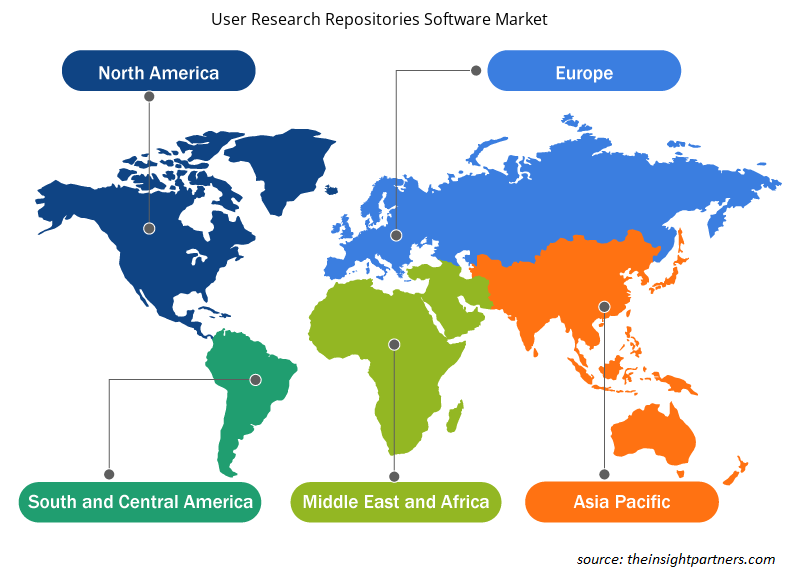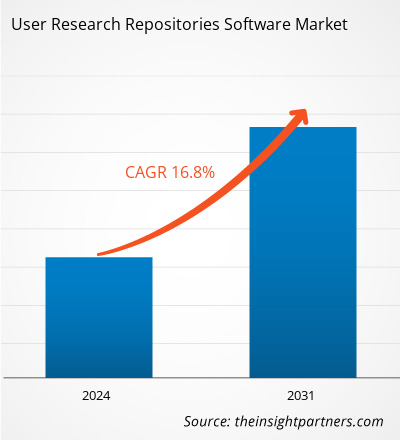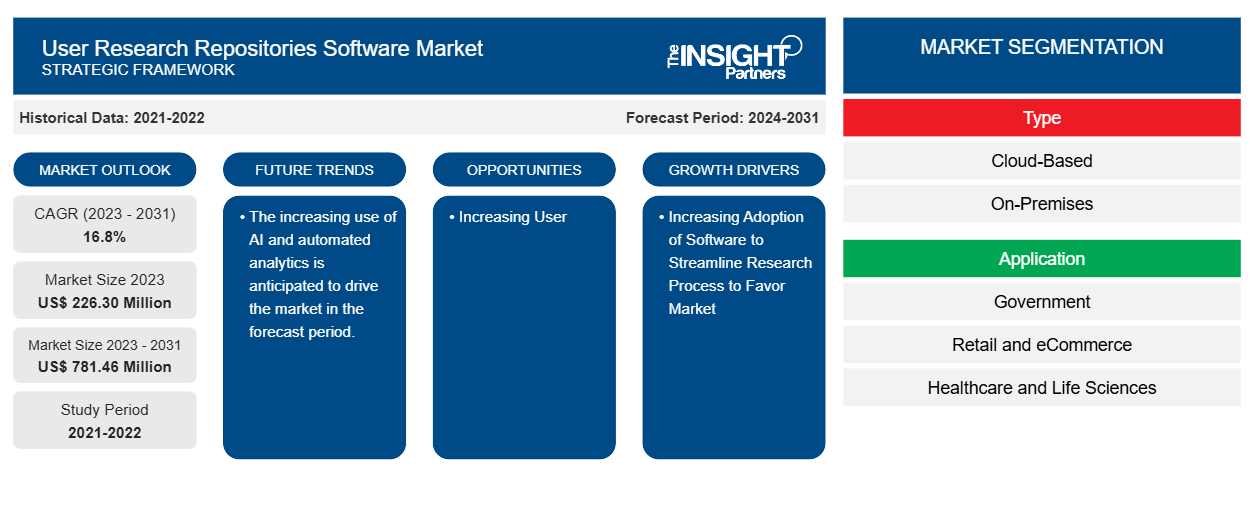Si prevede che il mercato dei software per repository di ricerca utente raggiungerà i 781,46 milioni di dollari entro il 2031, rispetto ai 226,30 milioni di dollari del 2023. Si prevede che il mercato registrerà un CAGR del 16,8% nel periodo 2023-2031. La crescente adozione di software per semplificare il processo di ricerca e la crescente domanda da parte delle startup UX-tech saranno probabilmente i principali driver e trend del mercato.
Analisi di mercato del software per repository di ricerche utente
La crescita del mercato dei software per repository di ricerca utente è attribuita alla crescente adozione di software per semplificare il processo di ricerca e alla crescente domanda da parte delle startup UX-tech. Inoltre, l'aumento dei dati sull'esperienza digitale degli utenti e l'uso di intelligenza artificiale e analisi sono tra gli altri fattori che sostengono la crescita del mercato dei software di gestione della promozione commerciale.
Panoramica del mercato dei software per repository di ricerca utente
Un repository di ricerca utente è un database centralizzato che include tutti i dati di ricerca utente, i report di ricerca UX e gli artefatti. Diversi team, come quelli di progettazione, prodotto, vendite e marketing, possono trovare spunti da progetti passati per contestualizzare gli scenari attuali e prendere decisioni informate.
Personalizza questo report in base alle tue esigenze
Riceverai la personalizzazione gratuita di qualsiasi report, comprese parti di questo report, o analisi a livello nazionale, pacchetto dati Excel, oltre a usufruire di grandi offerte e sconti per start-up e università
-
Scopri le principali tendenze di mercato in questo rapporto.Questo campione GRATUITO includerà analisi di dati che spaziano dalle tendenze di mercato alle stime e alle previsioni.
Driver e opportunità del mercato del software per repository di ricerche utente
Aumento dell'adozione di software per semplificare il processo di ricerca a favore del mercato
Il software di repository di ricerca può migliorare notevolmente l'efficienza organizzando i dati, semplificando i flussi di lavoro e riducendo il tempo dedicato alle attività manuali. Ciò rende il processo di ricerca più rapido e produttivo. Inoltre, con l'aumento del volume dei dati di ricerca, diventa fondamentale la necessità di soluzioni efficaci per la gestione dei dati. Il software di repository di ricerca aiuta a memorizzare, organizzare e recuperare facilmente grandi volumi di dati.
Migliorare l'esperienza digitale dell'utente.
Man mano che le esperienze digitali diventano più complesse e personalizzate, le organizzazioni hanno bisogno di approfondimenti più approfonditi sul comportamento e le preferenze degli utenti. I repository di ricerca degli utenti aiutano a consolidare e analizzare questi dati in modo efficace. Le aziende che danno priorità all'esperienza utente ottengono un vantaggio competitivo. Investire nei repository di ricerca degli utenti consente un miglioramento continuo dei prodotti digitali, portando a una migliore soddisfazione e fedeltà degli utenti. Inoltre, con un focus sull'esperienza utente, le decisioni sono sempre più guidate dai dati. I repository di ricerca degli utenti forniscono una posizione centralizzata per l'archiviazione e l'accesso ai dati di ricerca degli utenti, facilitando un processo decisionale più informato.
Analisi della segmentazione del rapporto di mercato del software per repository di ricerche utente
I segmenti chiave che hanno contribuito alla derivazione dell'analisi di mercato del software per repository di ricerca utente sono tipologia e applicazione.
- In base al tipo, il mercato dei software per repository di ricerca utente è suddiviso in cloud-based e on-premises. Si prevede che il segmento basato su cloud detenga una quota di mercato significativa nel periodo di previsione.
- In base all'applicazione, il mercato del software per repository di ricerca utente è suddiviso in governo, commercio al dettaglio ed e-commerce, sanità e scienze della vita, BFSI, trasporti e logistica, telecomunicazioni e IT, produzione e altri. Si prevede che il segmento governativo detenga una quota di mercato significativa nel periodo di previsione.BFSI, transportation and logistics, telecom and IT, manufacturing, and others. The government segment is anticipated to hold a significant market share in the forecast period.
Analisi della quota di mercato del software per repository di ricerca utente per area geografica
L'ambito geografico del rapporto di mercato sui software per repository di ricerca degli utenti è suddiviso principalmente in cinque regioni: Nord America, Asia Pacifico, Europa, Medio Oriente e Africa, e Sud e Centro America.
Il Nord America ha dominato il mercato del software per repository di ricerca utente. Le tendenze di adozione di tecnologie elevate in vari settori nella regione nordamericana hanno alimentato la crescita del mercato del software per repository di ricerca utente. Si prevede che fattori come l'adozione crescente di strumenti digitali e l'elevata spesa tecnologica da parte delle agenzie governative guideranno la crescita del mercato del software per repository di ricerca utente nordamericano. Inoltre, una forte enfasi sulla ricerca e sviluppo nelle economie sviluppate di Stati Uniti e Canada sta costringendo gli attori nordamericani a portare sul mercato soluzioni tecnologicamente avanzate. Inoltre, gli Stati Uniti hanno un gran numero di attori del mercato del software per repository di ricerca utente che si sono sempre più concentrati sullo sviluppo di soluzioni innovative. Tutti questi fattori contribuiscono alla crescita del mercato del software per repository di ricerca utente nella regione .fuelled the growth of the user research repositories software market. Factors such as increased adoption of digital tools and high technological spending by government agencies are expected to drive the North American user research repositories software market growth. Moreover, a strong emphasis on research and development in the developed economies of the US and Canada is forcing the North American players to bring technologically advanced solutions into the market. In addition, the US has a large number of user research repositories software market players who have been increasingly focusing on developing innovative solutions. All these factors contribute to the region's growth of the user research repositories
Repository di ricerche utente Mercato del software Approfondimenti regionali
Le tendenze regionali e i fattori che influenzano il mercato del software User Research Repositories durante il periodo di previsione sono stati ampiamente spiegati dagli analisti di Insight Partners. Questa sezione discute anche i segmenti e la geografia del mercato del software User Research Repositories in Nord America, Europa, Asia Pacifico, Medio Oriente e Africa e America centrale e meridionale.

- Ottieni i dati specifici regionali per il mercato del software di repository di ricerca degli utenti
Ambito del rapporto di mercato del software per repository di ricerca utente
| Attributo del report | Dettagli |
|---|---|
| Dimensioni del mercato nel 2023 | 226,30 milioni di dollari USA |
| Dimensioni del mercato entro il 2031 | 781,46 milioni di dollari USA |
| CAGR globale (2023-2031) | 16,8% |
| Dati storici | 2021-2022 |
| Periodo di previsione | 2024-2031 |
| Segmenti coperti |
Per tipo
|
| Regioni e Paesi coperti |
America del Nord
|
| Leader di mercato e profili aziendali chiave |
|
Repository di ricerche utente Software Market Players Densità: comprendere il suo impatto sulle dinamiche aziendali
Il mercato del software User Research Repositories sta crescendo rapidamente, spinto dalla crescente domanda degli utenti finali dovuta a fattori quali l'evoluzione delle preferenze dei consumatori, i progressi tecnologici e una maggiore consapevolezza dei vantaggi del prodotto. Con l'aumento della domanda, le aziende stanno ampliando le loro offerte, innovando per soddisfare le esigenze dei consumatori e capitalizzando sulle tendenze emergenti, il che alimenta ulteriormente la crescita del mercato.
La densità degli operatori di mercato si riferisce alla distribuzione di aziende o società che operano in un particolare mercato o settore. Indica quanti concorrenti (operatori di mercato) sono presenti in un dato spazio di mercato in relazione alle sue dimensioni o al valore di mercato totale.
Le principali aziende che operano nel mercato dei software per repository di ricerca utente sono:
- Pezzi di pastello, LLC
- Soluzioni Usertimes GmbH
- Tetra Insights, Inc.
- Savio Technology Inc.
- Rivela BM
- Società per azioni
Disclaimer : le aziende elencate sopra non sono classificate secondo un ordine particolare.

- Ottieni la panoramica dei principali attori del mercato dei software per repository di ricerca utente
Repository di ricerca utente Software Notizie di mercato e sviluppi recenti
Il mercato dei software per repository di ricerca utente viene valutato raccogliendo dati qualitativi e quantitativi dopo la ricerca primaria e secondaria, che includono importanti pubblicazioni aziendali, dati di associazioni e database. Di seguito sono elencati alcuni degli sviluppi nel mercato dei software per repository di ricerca utente:
- Tetra Insights, con sede a Boulder, una piattaforma di operazioni di ricerca, mira ad aiutare le aziende ad allineare l'esperienza del cliente con la strategia e l'esecuzione. Venerdì la società ha annunciato di aver raccolto un round di Serie A da 5 milioni di dollari. Access Venture Partners ha guidato il round con la partecipazione aggiuntiva di Next Frontier Capital e Active Capital. (Fonte: sito Web aziendale Tetra Insights con sede a Boulder, agosto 2021)
Copertura e risultati del rapporto di mercato del software per repository di ricerca utente
Il rapporto "Dimensioni e previsioni del mercato del software per repository di ricerca utente (2021-2031)" fornisce un'analisi dettagliata del mercato che copre le seguenti aree:
- Dimensioni e previsioni del mercato del software per repository di ricerca degli utenti a livello globale, regionale e nazionale per tutti i segmenti di mercato chiave coperti dall'ambito
- I software di repository di ricerca degli utenti, le tendenze del mercato e le dinamiche di mercato, come driver, vincoli e opportunità chiave
- Analisi dettagliata delle cinque forze PEST/Porter e SWOT
- Analisi di mercato del software di repository di ricerca degli utenti che copre le principali tendenze del mercato, il quadro globale e regionale, i principali attori, le normative e gli sviluppi recenti del mercato
- Analisi del panorama industriale e della concorrenza che copre la concentrazione del mercato, l'analisi della mappa di calore, i principali attori e gli sviluppi recenti per il mercato del software di repository di ricerca degli utenti
- Profili aziendali dettagliati
- Analisi storica (2 anni), anno base, previsione (7 anni) con CAGR
- Analisi PEST e SWOT
- Valore/volume delle dimensioni del mercato - Globale, Regionale, Nazionale
- Industria e panorama competitivo
- Set di dati Excel
Report recenti
Testimonianze
Motivo dell'acquisto
- Processo decisionale informato
- Comprensione delle dinamiche di mercato
- Analisi competitiva
- Analisi dei clienti
- Previsioni di mercato
- Mitigazione del rischio
- Pianificazione strategica
- Giustificazione degli investimenti
- Identificazione dei mercati emergenti
- Miglioramento delle strategie di marketing
- Aumento dell'efficienza operativa
- Allineamento alle tendenze normative























 Ottieni un campione gratuito per - Mercato del software per repository di ricerca utente
Ottieni un campione gratuito per - Mercato del software per repository di ricerca utente